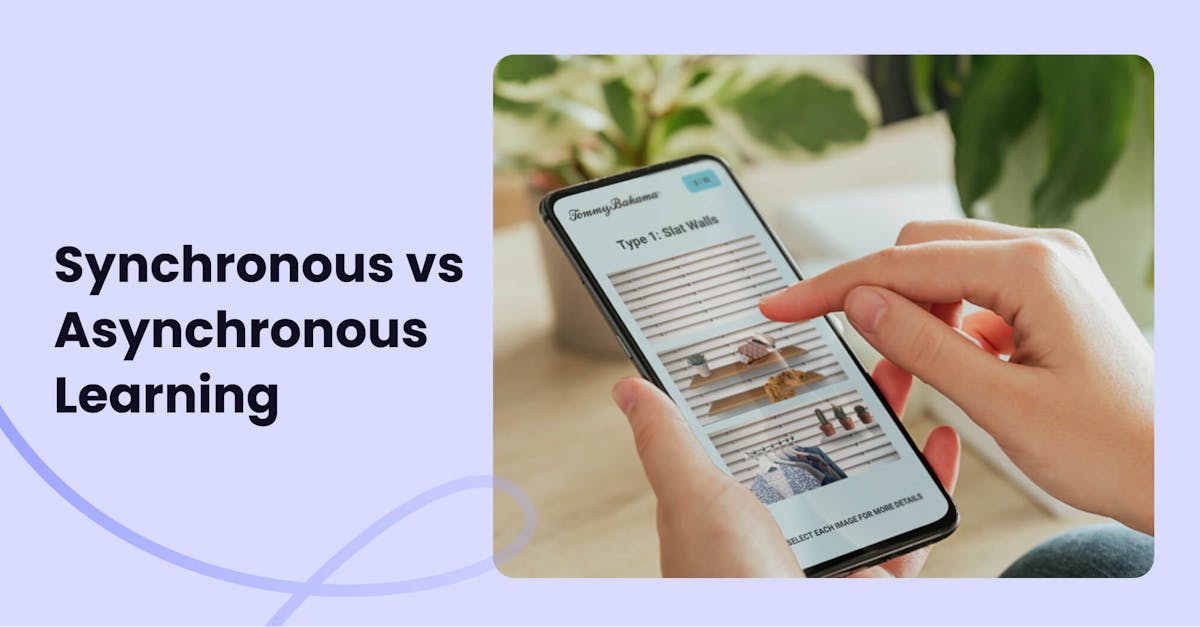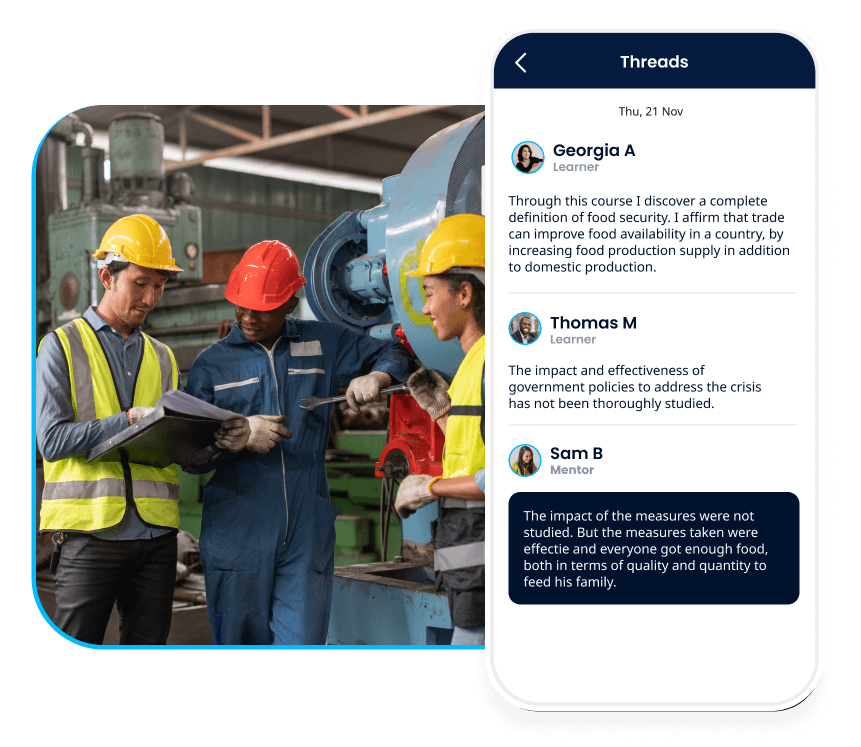Synchronous vs. Asynchronous Learning

Online learning has grown in popularity over the years, especially with the ease of access thanks to the internet. Nowadays, considering the bulk of free learning materials available online, a decent internet connection is as good as a classroom. These online programs have made the concept of asynchronous vs. synchronous learning more popular than ever.
Learning in the digital era can be done in two ways - synchronously and asynchronously. Both approaches have pros and cons and are suitable for different scenarios. In this article, we will delve into the differences between synchronous and asynchronous communication, explore their use cases, and understand the benefits of each method.
What is synchronous learning?
Synchronous learning refers to a method of learning where learners and instructors come together in real-time, engaging in live discussions, lectures, and activities. This type of learning aims to simulate a traditional classroom experience.

In synchronous learning, all learners are actively involved online at the same time as the instructor. For example, they can join a virtual classroom or video conference where the teacher presents the lesson, and learners can ask questions or participate in discussions in real-time.
This face-to-face interaction allows for immediate feedback, clarification, and the opportunity for students to engage with their peers. This form of learning is particularly useful for subjects that require hands-on practice, collaborative projects, or immediate feedback, such as language learning and problem-solving.
Create better synchronous and asynchronous learning experiences with EdApp today. Join now for free!
What is asynchronous learning?
If you’ve taken an online course in the past, you pretty much know a thing or two about the subject at hand. “Asynchronous” means not occurring at the same time or not simultaneously. That being said, this kind of setting allows learners to satisfy requirements at their own pace and time, as long as they are accomplished by the given deadline.

Online-asynchronous learning elements can include pre-recorded presentations, quizzes, discussion boards, and digital libraries, to name a few. As they don’t need to adhere to a conventional classroom setting, learners have more freedom when it comes to using their resources and polishing their work, resulting in a more personalized, learner-focused experience akin to informal learning.
Difference between synchronous and asynchronous
There are many benefits of asynchronous learning and asynchronous learning. Determining what works best for your training program can be tricky. Here are a few key differences to help you out.
Asynchronous learning characteristics
- Since all resources are readily available online, learners can access modules and finish tasks anytime, which can help promote work-life balance. They can also contribute and participate in group discourse through social media platforms or discussion boards, regardless of their time and location.
- The playing field is level since there’s no pressure to do things on the spot. Learners can take their time and go back as often as they want to focus on topics they may find more challenging.
- Conducting an asynchronous class meaning training sessions in the workplace is made more cost and time efficient, especially for companies that operate in different parts of the globe. Modules can be easily rolled out with the help of an effective learning management system which makes it easier to track progress, completion rates, and areas for improvement.
Synchronous learning characteristics
- Synchronous learning happens in real-time making it easy to gauge learner engagement and comprehension.
- Because of its social setting, it offers a sense of connectedness as it allows learners and teachers to interact during learning sessions.
- Questions, feedback, ideas, and opinions can be shared and addressed immediately.
The challenges of synchronous and asynchronous learning
Each learning type comes with its own set of challenges. For synchronous learning, technical difficulties like a slow internet connection and device malfunctions can, for example, leave a learner behind during a live online workshop, and miss important info they wouldn’t be able to catch up on.

Also, making sure that adequate contribution happens may pose a challenge for large groups of learners while instructors also have to make sure that no one person dominates the discussion. Differing work schedules/time zones can also make scheduling difficult to coordinate since the determined time can be favorable for some but not for others.

On the other hand, asynchronous learning may be more difficult for older learners who are used to a traditional classroom setting and have limited experience with navigating software and modern technology in general. While this allows for flexibility, asynchronous learners need strong self-discipline and good time-management skills to get their work done without any supervision.
Also, not being able to ask for help and get answers immediately may deter a student from progressing on their task. This is why it’s very beneficial if learners are given fun, engaging activities, well-designed courses, and active discussion boards that keep them motivated to help combat learner isolation.
Synchronous and asynchronous learning with EdApp
With EdApp, there’s no shortage of implementing synchronous or asynchronous learning. It’s a multi-award-winning learning management system built for today’s digital landscape. It focuses on delivering training through mobile devices, which makes it accessible and convenient to all employees regardless of time and location differences.
Training materials can be easily created, updated, and rolled out to specific learner groups within a company for a more targeted learning approach.

For your synchronous learning needs, you can arrange and have in-app meetings and check-ins with your learners using EdApp's Virtual Classroom functionality. It works with well-known video conferencing platforms like Zoom and Microsoft Teams. This lets you successfully communicate with and teach your team while preserving face-to-face engagement, even if you’re not physically present together.
EdApp also offers free, pre-made courses and lessons on a wide variety of topics (from Forklift Safety, to Bussing Techniques, to the Safe Operation of Dishwashers!) which instructors can implement right away, or customize as they see fit. EdApp is packed with tons of features to keep learners motivated. This includes interactive quizzes, gamification elements, and leaderboards to promote healthy competition between colleagues.

On the other hand, a notable feature to use for asynchronous learning is EdApp’s Discussions and Assignments. The Discussions feature aims to increase engagement and collaboration among peers. It cultivates an exchange of insights and learning, similar to a forum discussion. Providing feedback and mentoring becomes easier through this dynamic exchange.

Assignments are best suited for questions that need more comprehensive answers. Instructors can post an assignment task with varying options, such as making it a mandatory requirement, having it pushed to specific users, or making it universally accessible. When submitting assignments, learners can also include photos and videos to enrich their answers.
Author
Gabrielle Rivera
Gabrielle is an eLearning content writer for SC Training (formerly EdApp), a microlearning solution designed for today's digital habits. She creates content about cutting-edge learning technologies and resources to help companies deliver great training experiences. When not absorbed in writing, she spends her time playing video games and reading books.
